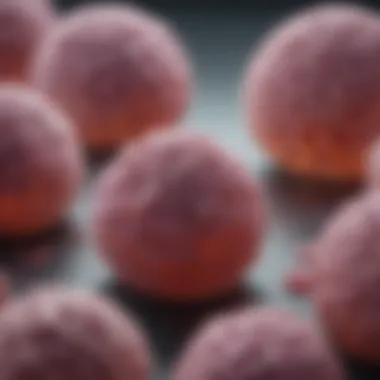Exploring the QIAamp FFPE Tissue Kit: Insights and Uses


Intro
In today’s fast-evolving landscape of molecular biology, the quest for reliable techniques to extract nucleic acids is of paramount importance. One of the standout tools in this arena is the QIAamp FFPE Tissue Kit. This innovative kit has transformed the way researchers handle formalin-fixed, paraffin-embedded (FFPE) tissues, opening the door to more accurate and efficient DNA and RNA extraction processes. With applications reaching far and wide—from cancer research to personalized medicine—it's a game changer in the field.
As advancements in biomedical research continue to accelerate, the significance of techniques that enable the analysis of preserved tissues becomes increasingly clear. This article will peel back the layers of the QIAamp FFPE Tissue Kit, delving into its composition, protocols, and the practical implications it holds in modern science.
Foreword to the QIAamp FFPE Tissue Kit
The QIAamp FFPE Tissue Kit represents a cornerstone in the toolkit of molecular biologists, especially those working with formalin-fixed paraffin-embedded (FFPE) tissues. These specimens are invaluable in the study of various diseases, particularly cancer, as they preserve histological details while still enabling genetic analysis. The ability to extract high-quality DNA and RNA from these samples is imperative for numerous applications, including biomarkers discovery and personalized medicine. This section aims to outline the foundational importance of the QIAamp FFPE Tissue Kit in the pursuit of such scientific endeavors, bringing into focus various elements and the benefits it offers.
Background of FFPE Tissues
Formalin-fixed paraffin-embedded tissues have been a staple in histopathology for decades. This method is primarily used for preserving tissue specimens, allowing for long-term storage without rapid decay. The fixation process stabilizes the proteins and nucleic acids within the tissues, a vital aspect that makes them suitable for a range of analyses. However, this preservation comes with its own set of challenges. The nucleic acids in FFPE tissues often become fragmented and chemically modified, complicating subsequent extraction and analysis.
Understanding the properties of FFPE tissues is crucial. Unlike fresh or frozen tissues that can yield nucleic acids of higher quality, FFPE samples may present obstacles like cross-linking of nucleic acids with proteins and other cellular components. This makes extraction techniques essential in overcoming such barriers. The QIAamp FFPE Tissue Kit leverages specific methodologies and reagents designed to navigate these challenges effectively, thereby extracting usable genetic material from even the most degraded samples.
Importance of DNA and RNA Extraction
Extracting DNA and RNA from FFPE tissues serves as a gateway to unlocking myriad research possibilities. The quality of this genetic material directly impacts downstream applications, such as PCR, sequencing, and genotyping. When researchers are able to obtain high-yielding, intact nucleic acids, the reliability of experimental results skyrocket.
"The success of molecular investigations hinges on the integrity of the extracted genetic material from precious FFPE samples."
In the realm of cancer research, for instance, the ability to dissect the genomic landscape of tumors—especially those stored in FFPE format—can provide insights into mutations that drive malignancies. This can aid in the development of targeted therapies tailored to individual patients, moving the field closer to effective personalized medicine. Furthermore, as research continues to advance, the ability to isolate RNA has become equally significant for transcriptomics, allowing scientists to evaluate gene expression levels and refine their hypotheses about cellular mechanisms.
In essence, the extraction techniques offered by the QIAamp FFPE Tissue Kit are not merely procedural; they are integral to the lifecycle of research, translating the static history captured within FFPE tissues into dynamic insights that can drive future discoveries.
Overview of the QIAamp FFPE Tissue Kit
When navigating the complexities of molecular biology, particularly in the realm of genetic research and diagnostics, the QIAamp FFPE Tissue Kit stands out as an essential instrument. This kit is specifically tailored for extracting DNA and RNA from formalin-fixed paraffin-embedded (FFPE) tissues, a common specimen type in clinical and research settings. Understanding the components and functionality of this kit can significantly enhance researchers' efficacy in obtaining high-quality nucleic acids, which are fundamental for diverse applications, from basic research to clinical diagnostics.
Components of the Kit
The QIAamp FFPE Tissue Kit comprises several vital components that facilitate the extraction process. Each ingredient plays a distinct role in ensuring efficient and effective retrieval of nucleic acids:
- Buffer ATL: This lysis buffer helps in breaking down the cell structure, releasing nucleic acids into the solution. Its composition is designed to work effectively with FFPE samples where tissue integrity may be compromised.
- Proteinase K: An enzyme crucial for the digesting of proteins, which is necessary for releasing DNA from the histone complexes it is often entangled with in FFPE tissues. Working at an optimal temperature is critical to maximize its activity.
- Buffer AL: This buffer aids in the precipitation of DNA, ensuring that contaminants can be washed away during the extraction steps.
- Column-based purification: The kit includes spin columns that employ silica membrane technology, which selectively binds DNA and RNA while permitting impurities to be washed away. This ensures a high degree of purity in the final product.
Additionally, the kit comes with reagents to help users ensure proper handling and storage of extracted nucleic acids. Each component is crafted to work synergistically, ensuring an optimized extraction process that yields reliable results every time.
Mechanism of Action
The QIAamp FFPE Tissue Kit’s methodology is a well-coordinated ballet of biochemical reactions designed to yield high-quality nucleic acids. Understanding its mechanism can provide insights into its effectiveness:
- Sample Lysis: The process begins with the lysis of the FFPE tissue. The Buffer ATL, together with Proteinase K, breaks apart cellular structures, liberating DNA and RNA from the embedding medium.
- Binding of Nucleic Acids: Once the nucleic acids are free, the sample is transferred to the spin column where Buffer AL assists in the binding process. Here, the silica membranes capture the nucleic acids while allowing residual proteins and contaminants to pass through, ensuring that only the desired materials remain.
- Washing and Elution: The kit protocols include washing steps using a specialized wash buffer to clean the bound nucleic acids. This purification step is crucial for obtaining high-quality samples that are suitable for downstream applications. Finally, an elution buffer is used to release the captured DNA and RNA from the column, ready for further analysis.


The efficiency of the QIAamp FFPE Tissue Kit is highly regarded in the scientific community, particularly for its reliability in yielding intact DNA and RNA from challenging sample types such as preserved tissue.
Overall, the QIAamp FFPE Tissue Kit is a well-designed solution that addresses the unique challenges posed by FFPE tissues in molecular biology. By understanding its components and mechanisms, researchers can make informed decisions on how to best utilize this kit in their work.
Protocol Steps for Using the Kit
In the world of molecular biology, specific protocols are the backbone of successful experiments, particularly when dealing with samples that have undergone preservation techniques like formalin-fixation and paraffin embedding. The QIAamp FFPE Tissue Kit offers a structured approach to DNA and RNA extraction, which is integral to ensuring high-quality results. Understanding the protocol steps not only helps in maximizing yield but also preserves the integrity of the nucleic acids, making follow-up analyses more reliable and insightful.
Sample Preparation
The first step, sample preparation, is as crucial as a solid foundation in a well-built house. Properly preparing the sample can have a significant impact on the final outcome of nucleic acid extraction. Within the QIAamp FFPE Tissue Kit, this process typically involves cutting tissue sections from an FFPE block into thin slides. These sections should ideally be around 5 to 10 micrometers thick, providing a balance between sufficient material for extraction and the minimizing of degradation risk.
The samples should be deparaffinized using xylene or specialized solutions. This step effectively removes paraffin wax that can interfere with downstream applications. After deparaffinization, the specimen is usually rehydrated in a series of ethanols, going from 100% down to 70%, before being washed with phosphate-buffered saline (PBS). This careful rinsing is fundamental because it prepares the tissues to properly release nucleic acids during the extraction process, ensuring their quality and integrity remain intact.
"Without proper sample prep, you might as well be fishing in an empty pond."
Extraction Process
Next comes the extraction process, where the real magic happens. This phase leverages the kit's proprietary lysis buffer that disrupts cellular structures and liberates DNA and RNA from the tissue. The lysis buffer's chemical composition, which often includes various detergents and chaotropic agents, plays a pivotal role in breaking down proteins and cellular membranes, thus freeing the nucleic acids.
After mixing the buffer with the sample, incubation at an elevated temperature is recommended. This not only enhances lysis but also increases the yield of nucleic acids. It's paramount to follow the incubation time specified in the protocol; too short may leave residual material, while too long can lead to degradation. Understanding temperature and time here is akin to knowing how long to brew tea—it's all about extracting the right flavors without letting bitterness seep in.
Purification Techniques
The final phase intricate to the use of the QIAamp FFPE Tissue Kit involves purification techniques that ensure the extracted DNA and RNA are free from contaminants and inhibitors. This step often employs spin-column technology provided by the kit. Following nucleic acid extraction, the sample is applied to a spin column where, under centrifugation, nucleic acids bind to a silica membrane, while impurities are washed away with buffer solutions.
Distilling further, elution buffers are then used to release purified DNA and RNA from the column into a clean vessel, ready for downstream applications such as PCR, sequencing, or other molecular techniques. It’s beneficial to note that the quality of the purified nucleic acids directly correlates to the overall experimental success, emphasizing the importance of these purification steps.
Maintaining best practices during these procedures, such as using clean tips and reagents, cannot be overstated. Skipping any facets of the protocol can lead to suboptimal outcomes. Hence, adhering to the defined steps is essential for minimizing variability in assays and achieving reproducibility in research.
Applications in Research
Exploring the various applications of the QIAamp FFPE Tissue Kit is akin to peeling away the layers of an onion — each layer reveals a slice of significant scientific progress facilitated by this tool. The ability to extract actionable nucleic acids from formalin-fixed paraffin-embedded tissues has been a game changer. Not only does it streamline the path from tissue samples to molecular insights, but it also opens a treasure trove of research possibilities.
Cancer Genomics
Cancer genomics is arguably one of the most prominent fields to benefit from the QIAamp FFPE Tissue Kit. With the high prevalence of FFPE samples in biobanks, researchers can delve into the genetic landscape of tumors without starting from scratch. The kit lays the groundwork for crucial projects aimed at understanding mutation patterns and genetic markers associated with different cancer types.
The extraction process, combined with high-throughput sequencing technologies, enables large-scale parallel studies. For instance, a research team focusing on breast cancer can analyze thousands of samples to identify specific mutations that correlate with patient responses to therapies. As the saying goes, knowledge is power, and in cancer genomics, this knowledge can lead to more effective treatment regimens and improved patient outcomes.
Histopathological Studies
Histopathology is the bedrock of disease diagnosis and, with the QIAamp FFPE Tissue Kit, research in this area hits an efficient stride. The quality of extracted nucleic acids is paramount, as this directly affects subsequent analyses like gene expression profiling or sequencing. This capability helps histopathologists glean critical information, bridging the gap between macroscopic observations from tissue slides and the underlying molecular mechanisms.
When doctors or researchers dive into the world of histopathological studies, they can relate findings on cellular architecture and disease progression back to molecular events. For instance, analyzing the expression levels of specific genes can provide insights into why certain tumors exhibit aggressive behavior when compared to others. This can be crucial in formulating tailored treatments for patients based on histopathological assessments.


Personalized Medicine
Personalized medicine is the quintessential goal of modern healthcare, and using the QIAamp FFPE Tissue Kit plays a crucial role in this endeavor. The kit's versatility allows for the extraction of high-quality DNA and RNA, enabling the identification of genetic profiles that inform treatment decisions. This ties back to the philosophical concept of one size does not fit all — treatments can now be tailored based on individual genetic backgrounds, optimizing therapeutics for better results.
For instance, in oncology, oncologists can analyze a patient’s tumor genomic data to customize chemotherapy protocols, enhancing the likelihood of efficacy while minimizing side effects. The kit's capabilities ensure that even precious archived tissue samples can contribute to this evolving landscape of precision medicine.
"The QIAamp FFPE Tissue Kit is a lifeline for enriching our understanding of genetic diseases and advancing the horizons of precision therapeutic strategies."
In summary, the applications of the QIAamp FFPE Tissue Kit extend far beyond mere extraction of nucleic acids. They offer insights that are deeply integrated into cancer genomics, histopathological studies, and personalized medicine, making it an indispensable tool in the modern researcher's toolkit.
Comparative Analysis with Other Kits
In the realm of molecular biology, especially when it comes to DNA and RNA extraction from formalin-fixed paraffin-embedded (FFPE) tissues, the choice of extraction kit can dramatically alter the outcome of the experiments. This section delves into the comparative analysis of the QIAamp FFPE Tissue Kit against its counterparts. Understanding variations in design, cost, efficacy, and ease of use is crucial for researchers to make informed decisions tailored to their specific needs. Choosing the right kit affects not only the yield and purity of extracted nucleic acids but also the overall success of downstream applications.
Strengths of the QIAamp Kit
One of the prominent strengths of the QIAamp FFPE Tissue Kit lies in its remarkable efficiency in processing FFPE samples. It is designed specifically for these challenging tissues, making it a go-to for many researchers. Here are some noteworthy strengths:
- High Recovery Rates: Researchers often cite superior recovery rates of both DNA and RNA, which means more reliable results in subsequent analyses. This is vital in genomic studies where even small amounts of nucleic acid can be critical.
- User-Friendly Protocol: The kit boasts a streamlined protocol that can be completed within a single day. This efficiency is particularly beneficial for labs under pressure to deliver results promptly. Moreover, the protocol is detailed, reducing variability between different users.
- Versatility Across Applications: Whether it’s for histopathology or cancer genomics, the QIAamp kit proves flexible across diverse applications, accommodating several types of FFPE samples.
- Robust Quality of Nucleic Acids: Many users have reported that the extracted DNA and RNA have shown better quality metrics, including integrity and purity, which are crucial for high-stakes downstream applications like sequencing and qPCR.
Limitations and Challenges
Despite its many advantages, the QIAamp FFPE Tissue Kit is not without its own limitations and challenges. Stakeholders must consider these factors when choosing their tools. These include:
- Cost: Relative to some other extraction kits, the QIAamp may carry a higher price tag, making it less appealing for budget-constrained laboratories or projects. This can influence choices significantly, especially in academic settings where funding is often limited.
- Processing of Old Samples: Some researchers have noted that very old FFPE blocks can lead to subpar extraction yields. Aged samples might have severely degraded nucleic acids, putting any kit's efficiency to the test.
- Specialized Equipment Needed: Though the kit aims for accessibility, some components may require specialized equipment, which could pose a limitation for labs lacking advanced machinery.
- User Variability in Execution: Variations in user technique can lead to inconsistent results, even with a well-designed kit. Training and expertise in handling the extraction protocol are essential to minimizing this issue.
The effectiveness of any kit lies significantly in the user’s understanding and execution of the specified protocols. Investing time in thorough training on the QIAamp kit can alleviate many of the challenges associated with nucleic acid extraction from FFPE samples.
In summary, comparative analysis of the QIAamp FFPE Tissue Kit with other extraction kits illuminates its valuable strengths while also revealing pertinent challenges. Researchers must weigh these aspects carefully to choose the most suitable extraction tools for their particular studies.
Troubleshooting Common Issues
In the realm of molecular biology, working with degraded samples can often feel like shooting arrows in the dark. The QIAamp FFPE Tissue Kit is designed to streamline the extraction of nucleic acids from formalin-fixed paraffin-embedded tissues, yet various complications can crop up during the extraction process. Troubleshooting common issues not only enhances the reliability of results but also helps in refining protocols suited for specific tissues or applications. Addressing these challenges paves the way for successful experiments, ensuring that researchers don't waste valuable time or resources.
Low Yield of Nucleic Acids
A frequent hurdle faced when using the QIAamp FFPE Kit is the low yield of nucleic acids. This issue can manifest due to several factors, ranging from sample handling to the inherent qualities of the FFPE tissues themselves.
- Sample Condition: The quality of the starting material is paramount. If the tissue was poorly fixed or if it's too old, nucleic acids might be extensively damaged, leading to subpar yields.
- Suboptimal Protocol Execution: Errors in protocol adherence can also contribute to lower yields. For instance, if the lysis step is cut short, the extraction might not efficiently liberate nucleic acids from the cellular debris.
- Inadequate Reagent Usage: It's crucial to ensure that buffers and enzymes are fresh and used at the recommended concentrations. Expired reagents can drastically reduce yield.
To tackle the low yield question, researchers should first evaluate their sample integrity. Keeping a close eye on the age of the sample can give a clue to its viability for extraction. Always double-check the execution steps, and consider running control samples alongside to gauge the extraction efficiency. If need be, a sample re-extraction approach using a different method or reviewing the extraction conditions may be warranted.
Degraded DNA/RNA Quality


Another issue that can plague the extraction process is the quality of the nucleic acids obtained. Degraded DNA or RNA can lead to unreliable downstream applications, skewing results significantly.
- Quality Assessment: Employing methods like spectrophotometry or gel electrophoresis can help assess nucleic acid quality. An A260/A280 ratio is often a quick indicator of purity – anything significantly off might warrant a reassessment of extraction techniques.
- Preservation Methods: The challenges of FFPE tissues lie in their preservation. The cross-linking caused by formalin can lead to fragmented nucleic acids, so understanding the age of samples and accompanying handling processes is critical.
- Optimizing Extraction Conditions: Using extended lysis times or incorporating additional steps can sometimes salvage degraded samples, albeit it must be noted that not all nucleic acids can be recovered, depending on their quality.
In order to enhance quality, consider repeating the extraction based on the above assessments. Additionally, exploring alternative extraction methods that specifically target degraded nucleic acids may yield better results.
"Understanding and rectifying issues around yield and quality is not just about sticking to a script; it's about adapting to the unique challenges posed by each sample."
In summary, while the QIAamp FFPE Tissue Kit is a powerful tool, being aware of potential pitfalls and knowing how to address them can significantly broaden its applicability in your research pursuits. Stay vigilant, and don't hesitate to iterate on your processes.
Future Directions in FFPE Tissue Research
The intricate world of molecular biology, particularly regarding cancer research, is continually evolving. The realm of FFPE (formalin-fixed paraffin-embedded) tissue research has opened new avenues and present as an essential toolkit for scientists. Understanding future directions is paramount because it not only nurtures the pursuit of knowledge but underlines the crucial role these tissues play in diagnostics and treatment. Different dimensions are emerging which hold the potential to revolutionize current methodologies and applications.
Innovations in Extraction Techniques
As we look towards the horizon, innovations in DNA and RNA extraction techniques become a critical focal point. Traditional methods can be time-consuming and result in suboptimal nucleic acid yield. Newer approaches, such as the incorporation of advanced magnetic bead technology, are surfacing, providing faster and more effective extraction processes. These modern techniques optimize the isolation of nucleic acids, specifically tailored from FFPE tissues, which can often be challenging due to the extensive cross-linking of proteins and nucleic acids caused by the embedding process.
For example, protocols utilizing enzymatic digestion followed by magnetic bead separation are noted for enhancing yield and quality. Not only can these methods significantly reduce hands-on time, but they also minimize the risk of contamination. As labs strive for efficiency, the merging of automation with these extraction methodologies may redefine how scientists approach sample preparation.
Emerging Applications in Oncology
With innovations in extraction methods, emerging applications in oncology are also coming to light. The analysis of FFPE tissues has already shown promise in cancer genomics, but novel applications are paving the way for even deeper insights.
One burgeoning area is the examination of tumor heterogeneity through single-cell sequencing techniques applied to FFPE samples. By understanding the cellular diversity within tumors, researchers can refine treatment strategies, driving forward the concept of personalized medicine. With every surgical specimen processed, the potential to unlock individual tumor characteristics is vast. This can lead to more targeted therapies and a better understanding of a patient's unique cancer profile.
Moreover, FFPE tissues can facilitate advancements in liquid biopsy technologies. The ability to correlate circulating tumor DNA (ctDNA) with changes found in FFPE samples can provide insights into treatment response, disease progression, and possible relapse. This convergence of methodologies presents a promising outlook for oncology, where real-time monitoring becomes feasible.
"The future of FFPE tissue research is not only about improving techniques but aligning them with innovative applications that bridge gaps in personalized treatment pathways."
Additionally, machine learning and bioinformatics tools are expected to play a vital role in elucidating complex datasets derived from FFPE tissues. Integrating these technologies will help parse large-scale genomic studies and distill actionable insights relevant to patient management.
End
The significance of the QIAamp FFPE Tissue Kit cannot be overstated, especially in an era where precision in molecular biology is paramount. This article has discussed various facets of the kit, underscoring its robust utility in extracting nucleic acids from FFPE tissues. The unparalleled capability to retrieve DNA and RNA from samples that have been formalin-fixed and paraffin-embedded is a game changer for researchers. It presents a unique pathway to accessing genetic material that can otherwise be lost amidst the degradation that often accompanies tissue preservation.
Summary of Key Findings
As this article delves into the various dimensions of the QIAamp FFPE Tissue Kit, several key findings emerge:
- The kit’s component design is tailored specifically to accommodate the complexities of FFPE samples.
- The methodology outlined not only streamlines the extraction process but also enhances the quality of the resultant nucleic acids.
- Its applications extend across multiple realms including oncology, histopathology, and personalized medicine, illustrating its versatility.
- The discussion on troubleshooting offers valuable insights into common issues, raising awareness about the potential pitfalls in nucleic acid extraction.
Understanding these elements equips researchers and practitioners with knowledge to utilize this kit effectively, amplifying their research capabilities.
Final Thoughts on the QIAamp FFPE Tissue Kit
The landscape of biology is ever-evolving, and tools like the QIAamp FFPE Tissue Kit are indispensable in championing that evolution. For those invested in the life sciences, knowing how to effectively apply this kit can dramatically impact the quality of their results and, subsequently, the advancement of scientific knowledge.
"Science knows no boundaries; it transcends time when we crack the code buried in preserved tissues."
As the field moves forward, the QIAamp FFPE Tissue Kit will likely remain a pivotal element in advancing both research and clinical practices.







